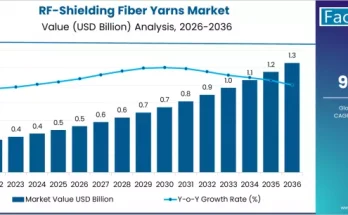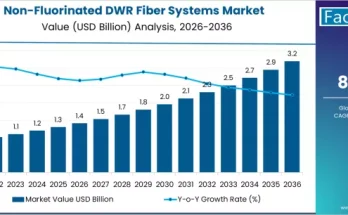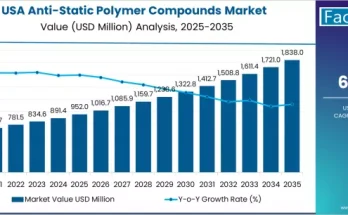The global silicone sealant market is on a steady growth trajectory, supported by robust demand from the construction, automotive, and electronics industries. According to a recent report by Fact.MR, the market is projected to increase from US$ 3,699.3 million in 2024 to US$ 5,528.7 million by 2034, reflecting a CAGR of 4.1% during the forecast period.
As industries seek versatile, durable, and environmentally compatible sealing solutions, silicone sealants have emerged as a material of choice for high-performance bonding, insulation, and waterproofing applications.
Strategic Market Drivers:
- Expanding Construction and Infrastructure Development
The construction sector remains a major growth engine for the silicone sealant market. Ongoing urbanization, coupled with rising investments in residential, commercial, and industrial projects, continues to propel demand. Silicone sealants are widely utilized in glazing, façade sealing, and weatherproofing applications due to their superior UV resistance, flexibility, and durability.
In addition, the increasing emphasis on sustainable and energy-efficient buildings has accelerated the adoption of low-VOC and eco-friendly sealant formulations.
- Automotive Industry’s Shift Toward Lightweighting and Durability
Automotive manufacturers are increasingly adopting silicone sealants for body assembly, glass bonding, and electrical insulation, driven by the industry’s focus on lightweight materials and extended component lifespans.
The sealants’ resistance to temperature extremes, vibration, and chemical exposure enhances vehicle performance, while their use in electric vehicles (EVs) for battery protection and insulation is creating new revenue streams for suppliers.
- Rising Demand in Electronics and Renewable Energy Applications
The growing adoption of silicone sealants in the electronics sector—especially for circuit board encapsulation, display bonding, and solar module assembly—is shaping a new frontier for the market.
Their high dielectric strength and thermal stability make them indispensable in protecting sensitive electronic components and enhancing product reliability.
Regional Growth Highlights
East Asia: The Manufacturing Epicenter
East Asia dominates global silicone sealant consumption, accounting for a major share of total demand. China, Japan, and South Korea are driving growth through large-scale infrastructure development, robust manufacturing output, and expanding electronics production. Favorable industrial policies and foreign investments further strengthen the region’s leadership in material innovation and supply chain capabilities.
North America: Emphasis on Innovation and Sustainability
The U.S. and Canada are witnessing consistent market expansion, underpinned by technological innovation and a strong focus on green building initiatives. The region’s automotive and aerospace industries are embracing high-performance sealants that meet stringent safety and emission standards, while manufacturers are investing in bio-based and recyclable silicone formulations.
Europe: Regulation-Driven Expansion
Europe’s market growth is propelled by strict environmental and performance standards, compelling manufacturers to introduce sustainable and energy-efficient sealing materials. Germany, France, and the U.K. are leading hubs for R&D and advanced construction solutions, with silicone sealants gaining ground in modular and prefabricated building systems.
Emerging Markets: Rising Urbanization and Industrialization
Latin America, the Middle East, and South Asia are emerging as high-potential markets, supported by rapid infrastructure expansion, urban housing demand, and government-led development programs. Increasing adoption of high-performance sealants in local manufacturing and energy sectors is expected to accelerate growth in these regions.
Market Segmentation Insights
By Type
- Acetoxy Silicone Sealants – Commonly used for general-purpose construction and glazing applications.
- Neutral Silicone Sealants – Gaining traction for metal, glass, and concrete bonding due to low corrosion risk.
- Amino and Oxime-based Sealants – Preferred for high-temperature and chemical-resistant applications.
By End Use Industry
- Building & Construction – Dominates the market owing to extensive usage in sealing, glazing, and structural joints.
- Automotive & Transportation – Growing adoption for bonding, gasketing, and vibration damping.
- Electrical & Electronics – Increasing use in insulating and protecting components.
- Industrial Assembly – Expanding role in equipment sealing and performance enhancement.
Challenges and Market Considerations
Despite a promising outlook, the silicone sealant market faces several challenges:
- Raw Material Price Volatility: Fluctuations in silicon metal and polymer costs affect profitability and pricing strategies.
- Environmental Regulations: Stricter VOC emission standards require constant reformulation of products to meet compliance.
- Competition from Polyurethane and Acrylic Sealants: Cost-effective alternatives pose challenges in price-sensitive markets.
- Supply Chain Disruptions: Geopolitical tensions and logistics constraints can impact raw material availability.
Competitive Landscape
The global silicone sealant market is characterized by innovation-driven competition, with key players focusing on sustainable formulations, product customization, and advanced adhesion technologies.
Key Companies Profiled:
- Wacker Chemie AG
- 3M
- Tremco Incorporated
- Bostik
- Sika AG
- Henkel Corporation
- Huntsman International LLC
- Mapei
- H.B. Fuller Company
- Shin-Etsu Chemical Company
These companies are expanding production capacities, strengthening distribution networks, and investing in smart sealant technologies for next-generation applications.
Recent Developments
- November 2022 – Wacker Chemie AG launched ELASTOSIL® LR 3078, a self-adhesive liquid silicone rubber designed for polycarbonate, offering superior adhesion and transparency.
- October 2022 – Shin-Etsu Chemical Company introduced Sicle, a silicon-oxygen-based water-repellent coating compound that enhances paper recyclability while minimizing environmental impact.
Future Outlook: Toward Sustainable and Intelligent Sealing Solutions
The next decade will witness a transformative shift in the silicone sealant industry, driven by sustainability, digitalization, and material science advancements. Manufacturers are increasingly integrating smart chemistry, eco-friendly materials, and AI-based quality control systems to enhance performance and reduce environmental footprint.
With robust demand across construction, mobility, and electronics sectors, the silicone sealant market is set for steady and resilient growth. Companies that prioritize innovation, sustainability, and regional collaboration will lead the next phase of market evolution—delivering advanced sealing solutions for a cleaner, smarter, and more connected world.


